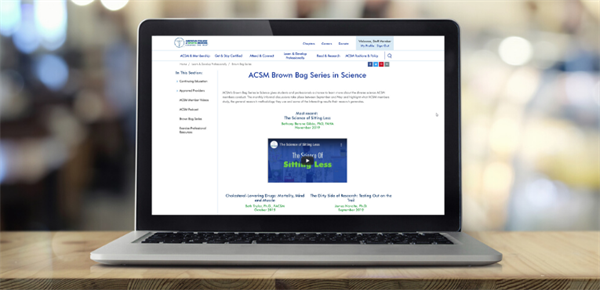Lynette L. Craft, Ph.D., FACSM & Beth Taylor, Ph.D., FACSM |
May
11, 2020
“A Well Educated Mind Will Always Have More Questions Than Answers”
-Helen Keller
 If the spring semester, with all of its challenges and changes, left you exhausted, you’re not alone. Faculty were asked to pivot quickly to online instruction and to identify innovative ways to make remote learning an engaging success. With the likely extension of online coursework persisting into the summer, you and your students may feel unmotivated and ready to say, “I didn’t sign up for THIS!”
If the spring semester, with all of its challenges and changes, left you exhausted, you’re not alone. Faculty were asked to pivot quickly to online instruction and to identify innovative ways to make remote learning an engaging success. With the likely extension of online coursework persisting into the summer, you and your students may feel unmotivated and ready to say, “I didn’t sign up for THIS!”
The struggle to a) deliver the best educational experience possible, while b) simultaneously covering necessary content and c) integrating real-life, hands-on, conversation-starting material requires significant time and resources. This is where ACSM can help! The ACSM Brown Bag in Science Webinars can be a great resource to stimulate concept-based learning and analytical thinking, while providing novel opportunities for external discussion and inquiry in the virtual world.
What are the ACSM Brown Bag in Science Webinars, you may ask? In the fall of 2017, ACSM launched its Brown Bag Series in Science. The primary goal of these webinars is to expose ACSM students to the breadth of research that ACSM members conduct. The webinars are delivered at the “student level,” in order to provide a non-intimidating opportunity for students to engage with our member presenters and to learn more about their work. Generally, the presenters discuss the research questions they are trying to answer, the methods that they use, and some interesting insights regarding their data and findings. The presentation is followed by a period of Q & A when participants have the opportunity to join the discussion and to ask their “burning” questions. The recorded webinars are freely available for access, download and use.
ACSM has been very fortunate over the past three years to have many outstanding members share their work in this webinar series. A variety of topics have been covered, such as thermoregulation, sport nutrition, exercise and mental health, physical activity behavior, chronic disease, sport performance and injury, technology and research with the armed forces.
Now, we’re not suggesting that assigning the ACSM Webinars alone should substitute for a traditional learning experience. Instead, you can use the webinars to complement your students’ learning in other areas by pairing each recording with supplementary, thought-provoking and fun assignments. For example, on a general level, an instructor can:
- Use the webinars as an activity to spark discussion on current topics, assigning students to do independent assessments of Google search queries, media articles and/or commercial products to establish public interest and need
- Ask students to compare/contrast the research methodologies used within several webinars
- Develop the skill of science communication by assigning a social media project where students have to develop three tweets to market a webinar or an infographic that summarizes a major theme from the presentation
- Assess a webinar to identify the five most pressing research questions that should be answered next
- Assign one of the presenter’s papers to the class and ask students to conceptualize a novel schematic on the larger scientific topic, integrating the presenter’s work
In addition, ACSM Webinars can be used to foster external communication, activities and discussion. Asking students to interview family members and peers (in-person or via electronic communication) about a topic beforehand highlights the relevance of the topic for practical application. For example, if the ACSM Webinar is on thermoregulation, students can be asked to survey friends and family about their experiences with exercise in the heat or their knowledge of heat stress and safety, and/or present a case study or article published in the popular press around the topic. Moreover, assigning a laboratory assessment afterwards can tie the Webinar to applied science. Sticking with the thermoregulation example, students can be asked to exercise in different settings (inside, with several layers of clothes on vs. outside in fewer layers) while monitoring performance indicators and fluid intake.
This Spring, all instructors were forced quickly to adapt to new online educational strategies, a challenge that has been made more exhausting and challenging due to the absence of resources, continued uncertainty and lack of in-person interactions. Our advice? Fight instructional exhaustion by using the ACSM Brown Bag in Science Webinars. With these in hand, students can question the science… rather than the situation.
Lynette L. Craft, Ph.D., FACSM, completed her Ph.D. in Kinesiology at Michigan State University and post-doctoral training in Health Psychology at Boston University School of Medicine. She currently serves as the ACSM Chief Science Officer.
Beth A. Taylor, Ph.D., FACSM, is an Associate Professor of Kinesiology at University of Connecticut as well as the Director of Exercise Physiology Research at Hartford Hospital. Her research interests focus on interactions between exercise, aging, cardiovascular disease and commonly used cardiovascular medications. An avid runner herself, Dr. Taylor has also conducted studies at the Boston and Hartford Marathons to determine the effects of sustained endurance exercise on blood clot risk, markers of cardiovascular injury and stress, and the effects of cholesterol-lowering drugs on these biomarkers.